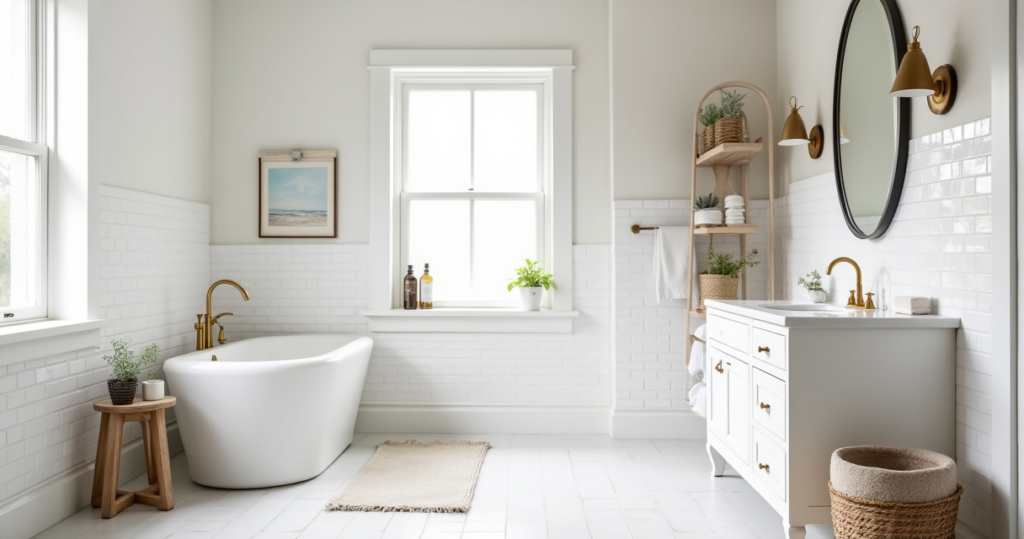Can we talk for a moment about why so many get the idea of “farmhouse” wrong? I walk into spaces filled to the brim with mass-produced signs about family and distressed-by-machine furniture, and I feel a sense of dissonance. It has the look of rustic, but it lacks the soul. It’s a collection of things, not a feeling of place.
The spirit of a true farmhouse is not about accumulating more rustic objects. It’s about an appreciation for the simple, the sturdy, and the authentic. It is born from a life connected to the land and the seasons. In Japanese design, we have a similar concept—wabi-sabi, the beauty of things imperfect, impermanent, and incomplete. This is where these two worlds meet. It’s not about having less, but about finding profound meaning in simplicity. Forget the noise of fleeting trends. What truly matters is creating a sanctuary—a space that feels honest, calm, and deeply connected to nature.
Laying the Foundation: Planning Your Farmhouse Aesthetic (Part 1)
Before you select a single towel or faucet, we must begin with intention. The foundation of a space is not built with wood and nails, but with clarity of purpose. This first phase is about establishing the feeling you wish to cultivate—the quiet hum beneath the surface of the design. We will explore the path you wish to walk and the materials that will ground your journey.
1. Defining Your Preferred Farmhouse Aesthetic: Modern Chic vs. Traditional Rustic
People often present this as a simple choice between old and new, but it is deeper than that. This decision is about the energy you want to cultivate. “Traditional Rustic” is a full embrace of wabi-sabi—it celebrates the visible history of objects, the cracks in the wood, the patina on the metal. It finds beauty in the story of time passing. It is warm, enveloping, and rooted in nostalgia.
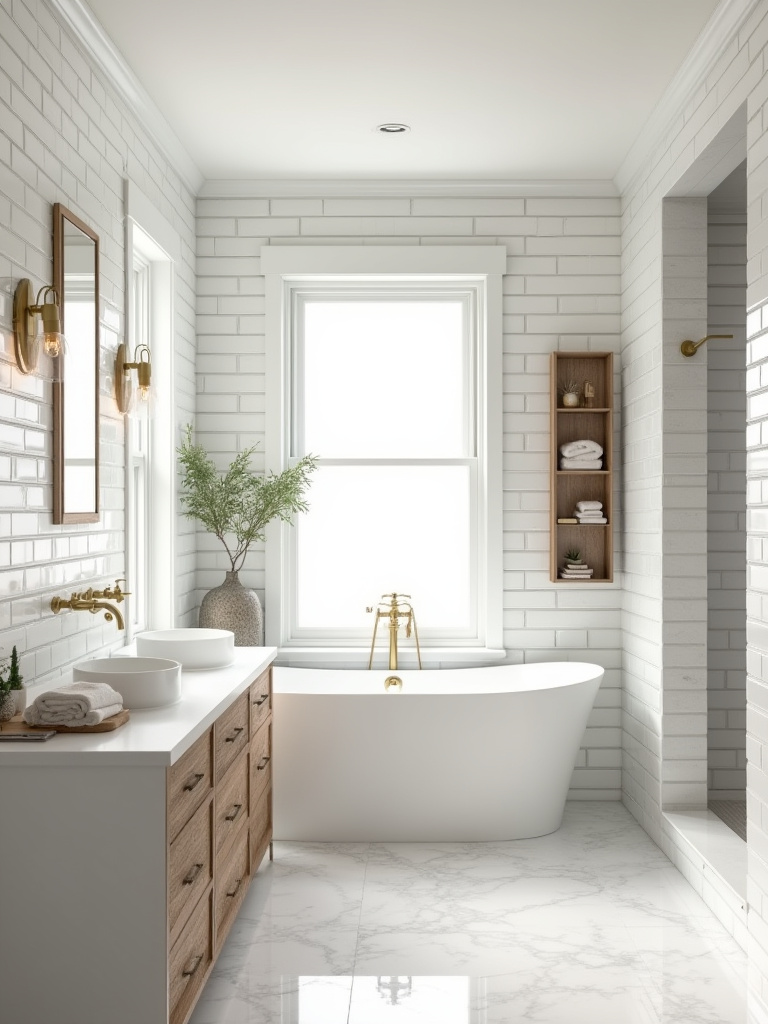
“Modern Chic” is a quieter conversation between past and present. It uses the clean lines and open space—what we call ma—of modern design to showcase the soul of a few rustic elements. The textures are still there, but they exist within a calmer, more edited framework. Ask yourself not what you want your bathroom to look like, but how you want to feel when you are in it: embraced by the past, or calmed by a balance of old and new?
2. Embrace a Neutral Color Palette for a Calming and Bright Base
A neutral palette is not about being safe or uninspired. It is about creating silence. Think of a canvas. A busy, colorful background competes with the subject. A quiet, neutral one allows the subject to speak clearly. Your walls, tiles, and large fixtures are the canvas of your bathroom. Whites, soft grays, and warm creams are not the main event; they are the supportive quiet that allows the real soul of the space to emerge.
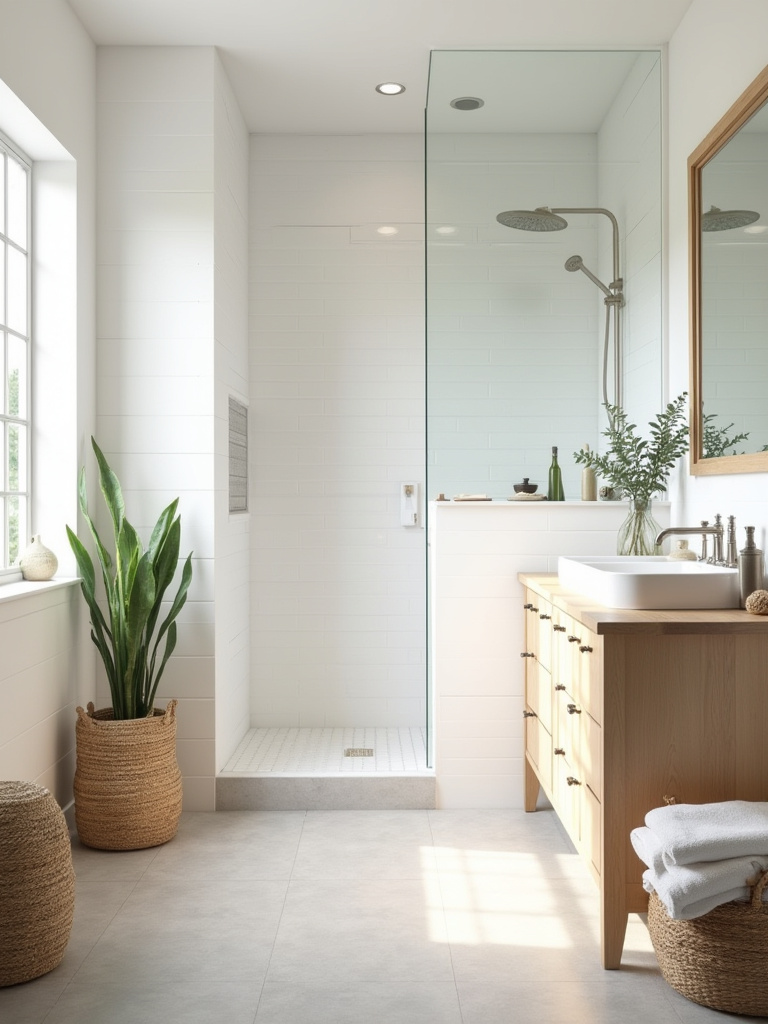
This quiet backdrop gives power to the texture of a wooden vanity, the form of a Freestanding Tub, or the deep color of an oil-rubbed bronze faucet. It is the practice of ma, or negative space. By creating visual quiet, you give each carefully chosen object room to breathe and express its true character. The calmness of the space is not an accident; it is the deliberate result of giving things emptiness to exist within.
3. Integrate Abundant natural materials: Reclaimed Wood, Stone, and Wicker
The essence of farmhouse living is a connection to the earth, and this must be felt, not just seen. Bringing natural materials into your bathroom is about inviting nature to be part of your daily rituals. A piece of reclaimed wood is not just a shelf or a vanity; it holds the energy of the tree it came from, the barn it lived in. Its grain tells a story that no factory can replicate.
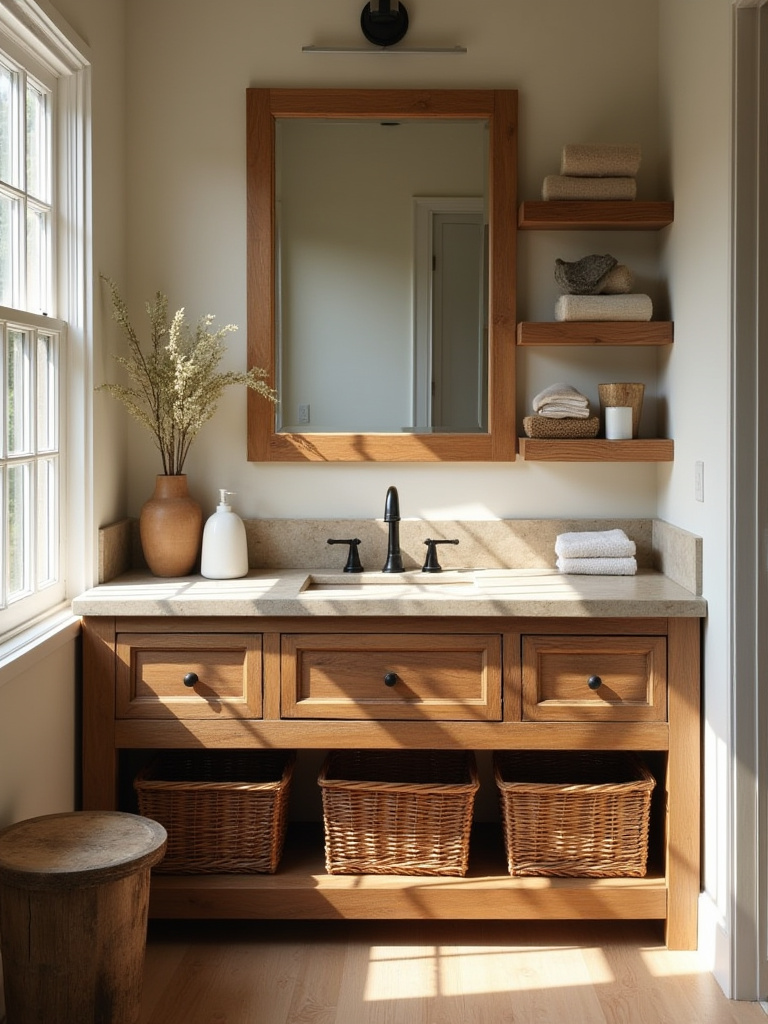
Stone grounds us. To stand on a slate tile or touch a stone vessel sink is to connect with something ancient and solid. Wicker and jute, with their woven imperfections, speak of human hands and humble origins. These are not mere decorations. They are reminders of the real, imperfect, and beautiful world outside our walls. We bring them inside to create a space that feels honest and alive.
4. Master the Art of Decluttering: Cultivating a Serene and Spacious Environment
Here is where the commercial idea of “farmhouse” and the soulful reality diverge most sharply. True simplicity, or Kanso, is not achieved by buying more baskets to hide your clutter. It is achieved by honestly assessing what is necessary. Before you add a single decorative item, you must first create space. A cluttered countertop is a cluttered mind.
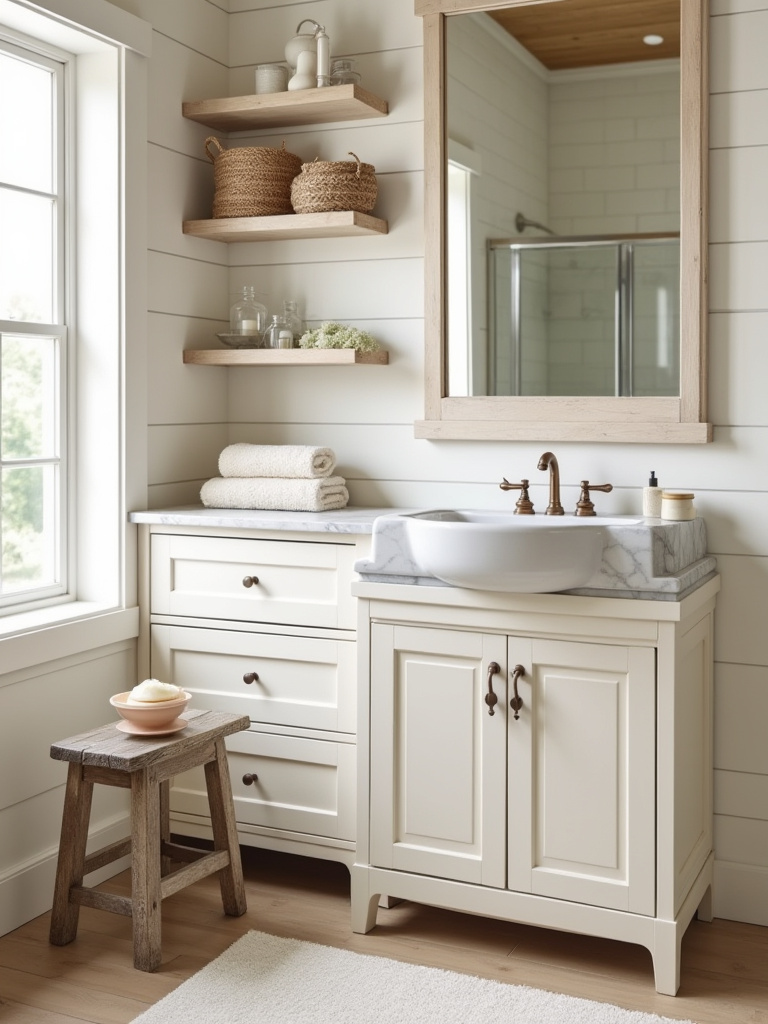
Remove everything. Clean the surfaces. Then, bring back only what is essential for your daily rituals and what brings you a genuine sense of peace or beauty. Everything else is noise. The goal is to create a space where the few things that remain can be truly seen and appreciated. An empty corner is not a failure of design; it is a moment of quiet, a place for the eye to rest. This is the art of subtraction.
Laying the Foundation: Planning Your Farmhouse Aesthetic (Part 2)
Now that we have established a philosophy for our space, we can approach the practical matter of bringing it into being. This is not about spending endlessly, but about spending mindfully. Where we choose to invest our resources reflects what we truly value in the design, and a thoughtful plan ensures that every choice serves our ultimate goal: a serene and authentic retreat.
5. Strategic Budgeting: Prioritizing High-Impact Farmhouse Accents First
A budget is not a restriction; it is a tool for focus. Instead of scattering your resources across many small, insignificant items, concentrate your energy on the pieces that form the soul of the room. A beautiful, handcrafted wooden vanity tells a more powerful story than fifty small, generic accessories. A single, perfect set of vintage-inspired light fixtures can define the entire atmosphere.
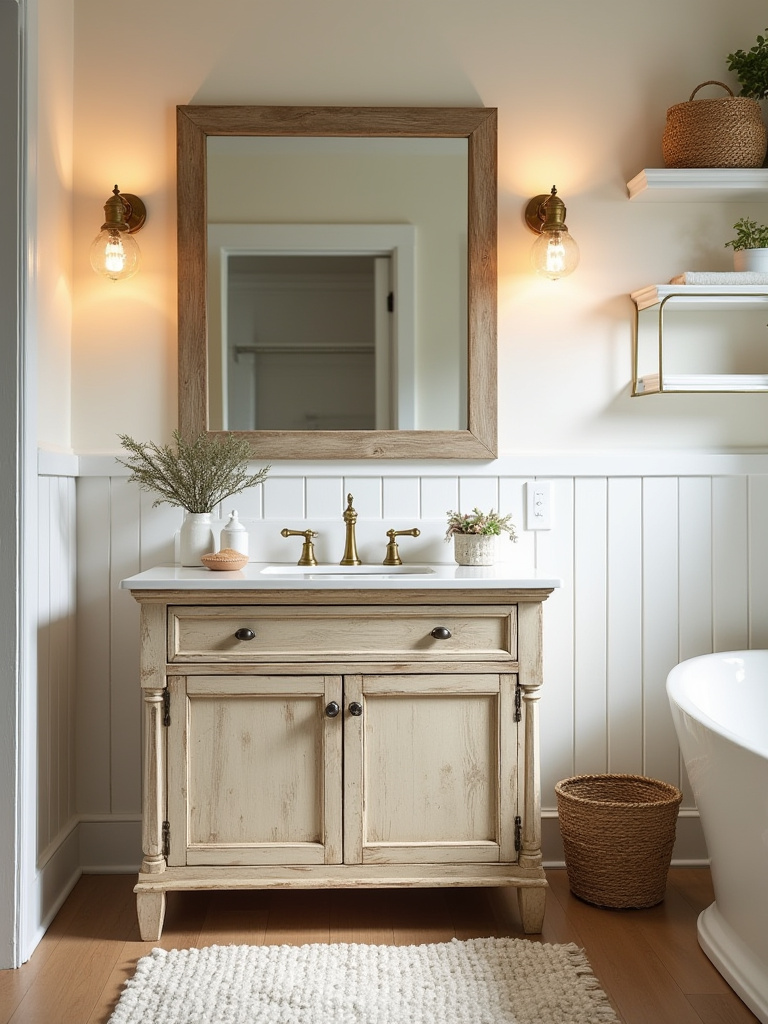
Identify the one or two elements that will be the heart of your bathroom. Perhaps it is the vanity, a freestanding tub, or the tile underfoot. Devote the majority of your budget to making these elements truly special. For the rest, you can be resourceful and patient. This approach ensures your bathroom has a strong, authentic core. The other pieces are simply quiet supporters of this central story.
Core Elements: Selecting Fixtures and Structural Charms (Part 1)
The core elements are the bones of the space. They are the large, functional pieces that will define the room’s character for years to come. These choices should be made slowly and with great care, as they will anchor every other decision you make. They are the quiet, sturdy pillars upon which the softer, more ephemeral details will rest.
6. Choosing the Perfect Farmhouse Vanity: Solid Wood, Distressed, or Upcycled
The vanity is the altar of the bathroom. It is where our daily rituals of cleansing and preparation take place. It should not feel disposable or anonymous. A solid wood vanity speaks of permanence and strength. One with a distressed finish tells a story of use, of life lived—this is pure wabi-sabi. The paint is worn where hands have touched it for years.
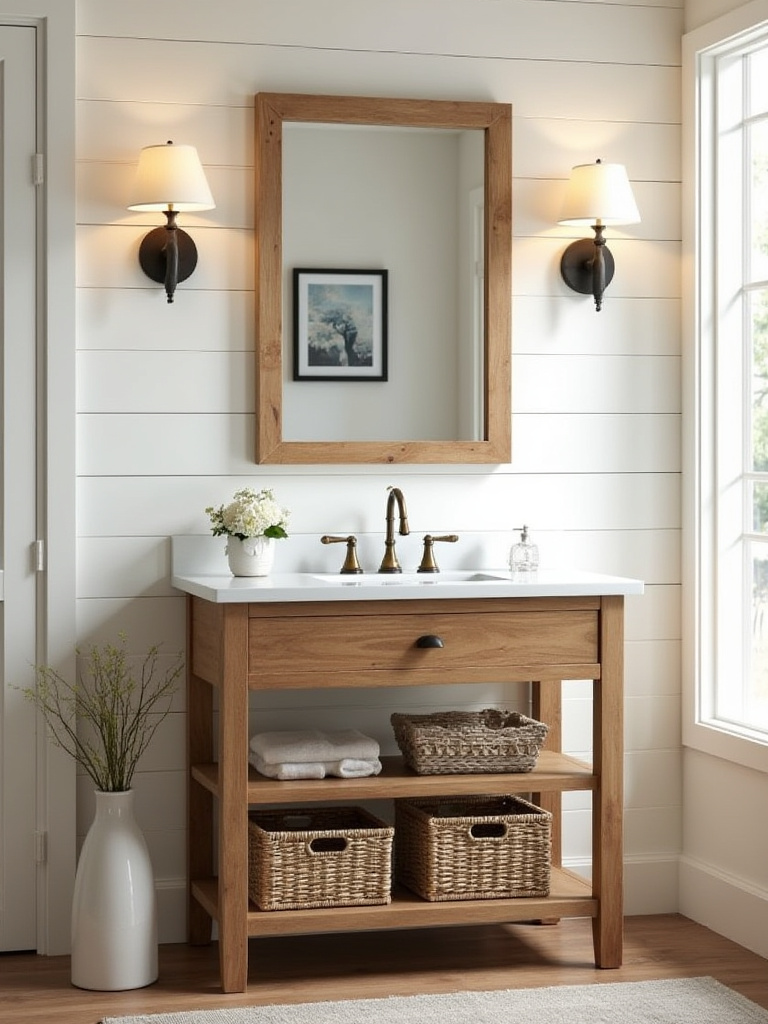
Better still is an upcycled piece—an old dresser or console table given new life. I once saw a client use a small, sturdy cabinet that had belonged to her grandmother. Every time she used the sink, she was quietly connected to her own history. This is what you should seek: a piece with resonance, a piece that has more to say than simply “I am new.”
7. Install a Statement Mirror: Ornate Wooden Frame, Galvanized, or Vintage Inspired
The mirror in a bathroom does more than reflect your face; it reflects the energy of the entire space. It is a piece of functional art. The frame you choose is as important as the reflection itself. A simple, raw wooden frame speaks of honesty. A galvanized metal one introduces a touch of cool, industrial history.
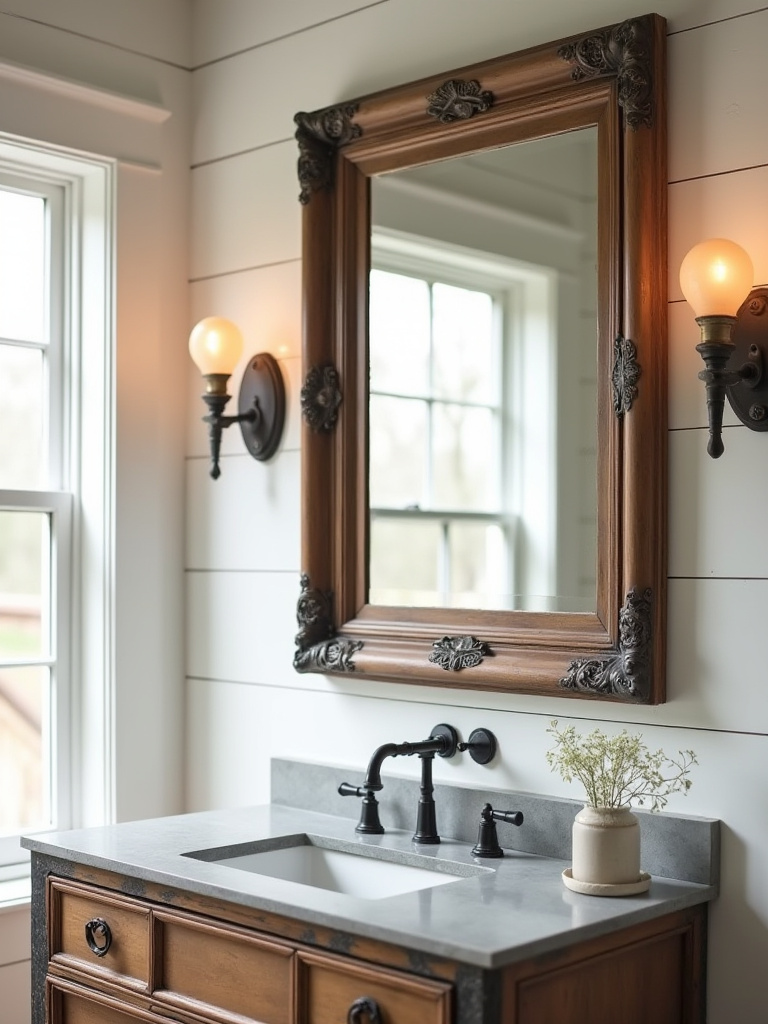
I find that a mirror with a story is always best. A vintage find, with its slightly imperfect glass and time-worn frame, adds a layer of soul that a new mirror cannot. It reminds us that beauty is not about perfection. When you look into it, you see not only yourself, but a whisper of all the years that have passed before.
8. Opt for a Classic Freestanding or Clawfoot Bathtub for Timeless Appeal
A built-in bathtub is a utility. A freestanding tub is a sculpture. It occupies the space as an object of beauty in its own right, inviting contemplation. A clawfoot tub, in particular, has a grace and personality that transforms bathing from a task into a ceremony. It holds the water, but it also holds the center of the room.
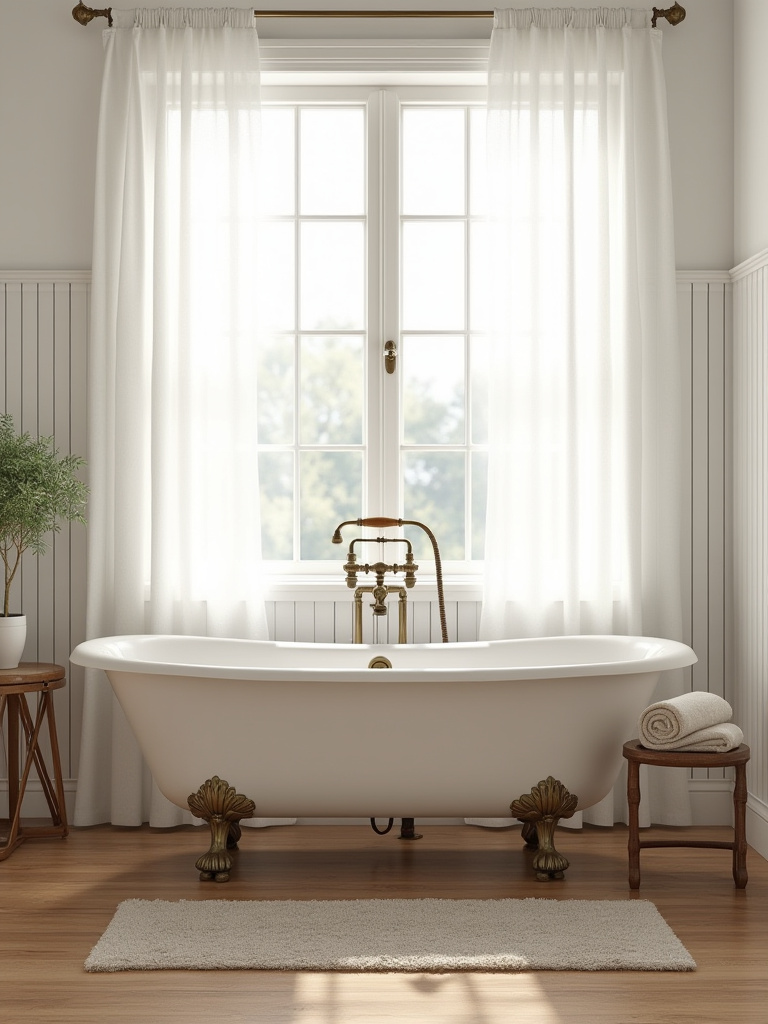
By pulling the tub away from the walls, you create a more dynamic sense of space. It requires you to consider the room from all angles and makes the act of bathing feel more intentional and luxurious. It becomes a destination within the room, a place to consciously retreat and restore oneself.
9. Incorporate Farm-Inspired Sinks: Apron-Front, Trough, or Rustic Vessel Bowls
The sink is a point of constant interaction. The feel of the material beneath your hands matters. An apron-front sink, with its deep basin and sturdy presence, evokes a sense of timeless utility. It feels generous and hardworking. A long trough sink suggests a communal, historical space, a place of shared purpose.
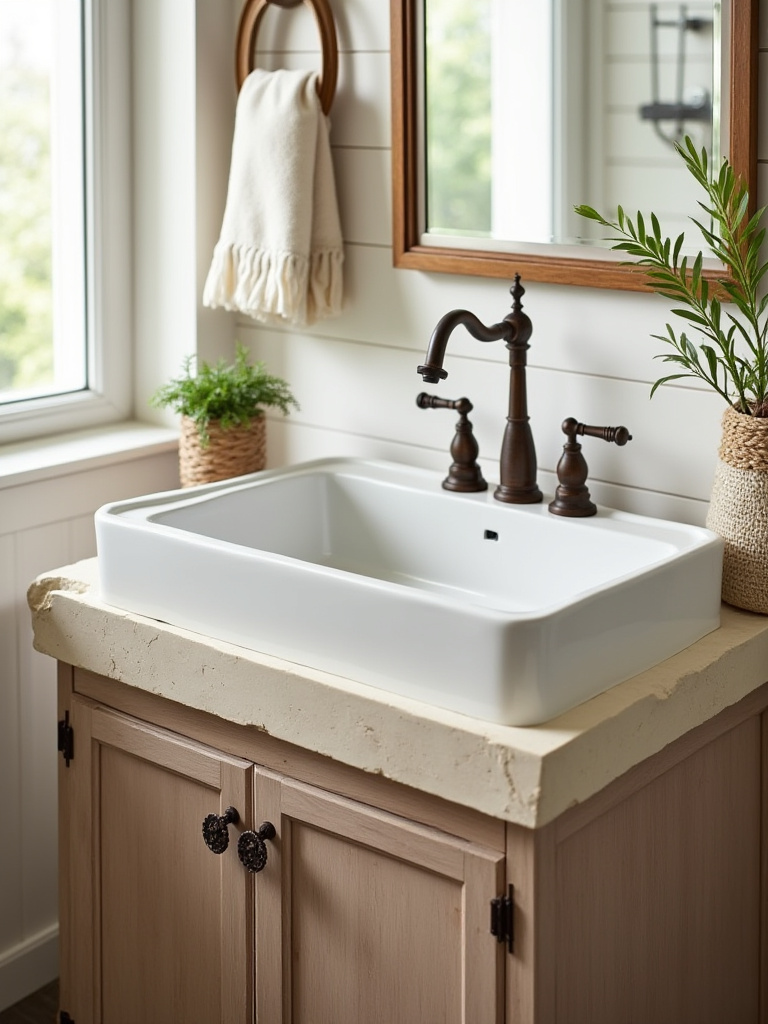
A vessel bowl made of stone or hammered copper offers a more tactile, organic experience. To run water over cool, smooth river stone or into a bowl that shows the marks of the artisan’s hammer is to engage with the elements in a simple, direct way. Your choice of sink shapes the character of your daily ritual.
Core Elements: Selecting Fixtures and Structural Charms (Part 2)
Having placed the largest pieces, we now turn our attention to the elements that connect them. The fixtures and surfaces are the grammar of our design language, creating a cohesive story. These are the details that build a sense of rhythm and texture, transforming a collection of objects into a harmonious environment.
10. Upgrade Faucets and Hardware: Matte Black, Oil-Rubbed Bronze, or Brushed Nickel
A faucet is where we meet the water. Its weight, its form, the way the handle moves—these small details contribute to the sensory experience of the space. Generic, polished chrome feels anonymous. But a finish with character can elevate the entire room. Oil-rubbed bronze develops a beautiful patina—the sabi, or elegant rust of age—that deepens over time, recording the history of its use.
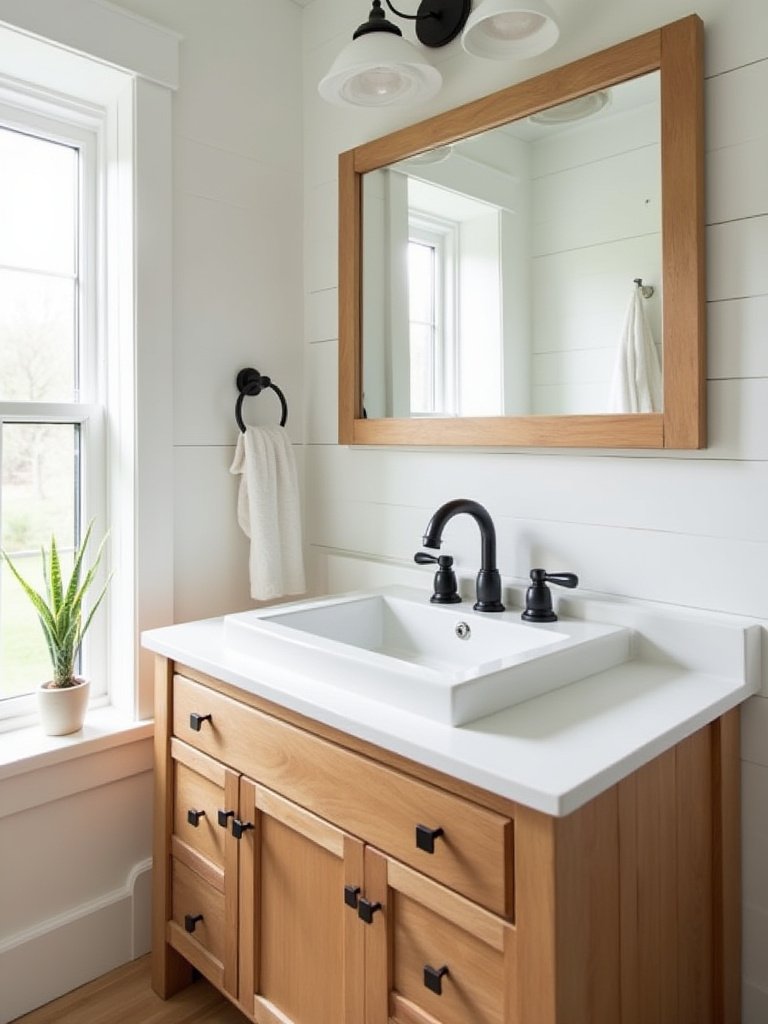
Matte black provides a modern, graphic contrast that allows the form of the faucet to stand out as a simple, strong silhouette. Brushed nickel is a softer, quieter choice that complements other elements without demanding attention. Choose one finish and carry it through the space with intention, from the faucet to the drawer pulls, to create a sense of unity and calm.
11. Enhance Walls with Shiplap, Board and Batten, or Classic subway tile
Texture is the language of natural spaces. A flat, painted wall can feel lifeless. Introducing a treatment like shiplap or board and batten is not about following a trend; it is about adding shadow, line, and a sense of hand-craftsmanship. The horizontal lines of shiplap can make a space feel wider and more restful. The verticality of board and batten can lend a room a sense of dignity and height.
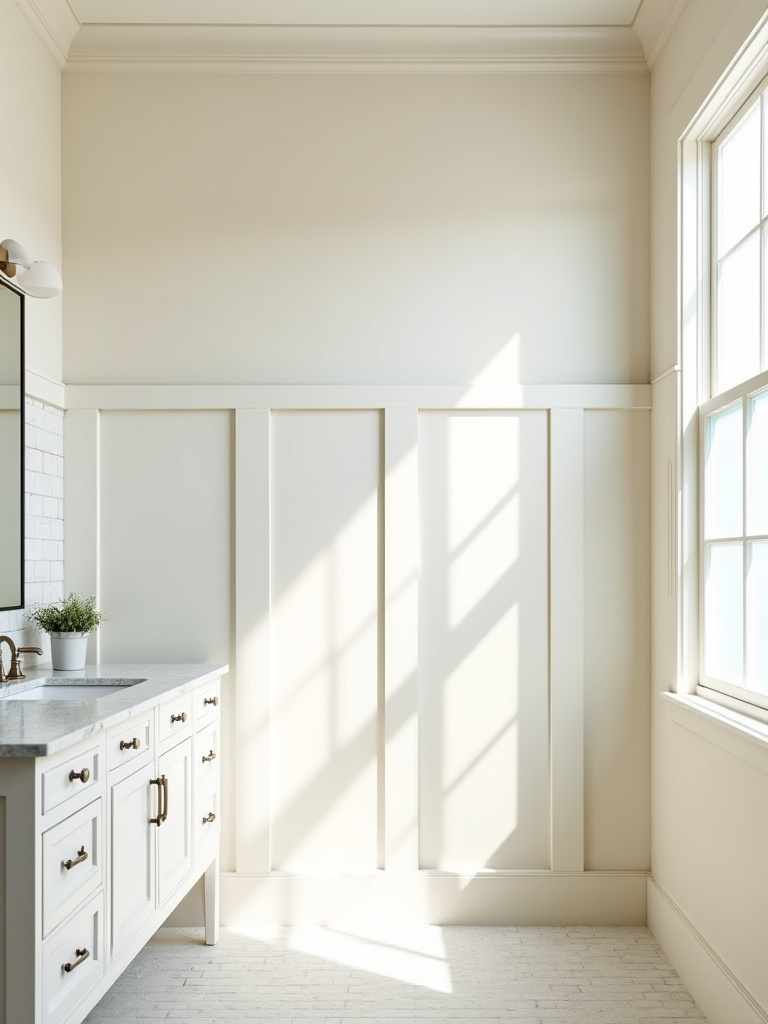
“True beauty speaks of imperfection, of the hand of the maker, and the passage of time.”
This is also why classic subway tile endures. Its beauty lies in its simplicity and the subtle rhythm of the grout lines. The pattern provides a quiet, geometric texture that serves as a humble backdrop for the more expressive elements in the room. Each of these choices is a way of giving the walls a voice.
12. Select Rustic Flooring Solutions: Wide Plank Hardwood or Patterned Cement Tiles
The floor is what connects us to the room. It should feel solid and authentic beneath our feet. Wide plank wood, whether real or a convincing substitute, gives the feeling of an old farmhouse. The width of the boards slows the space down, making it feel more expansive and grounded. Seeing the grain and knots reminds us of the living tree.
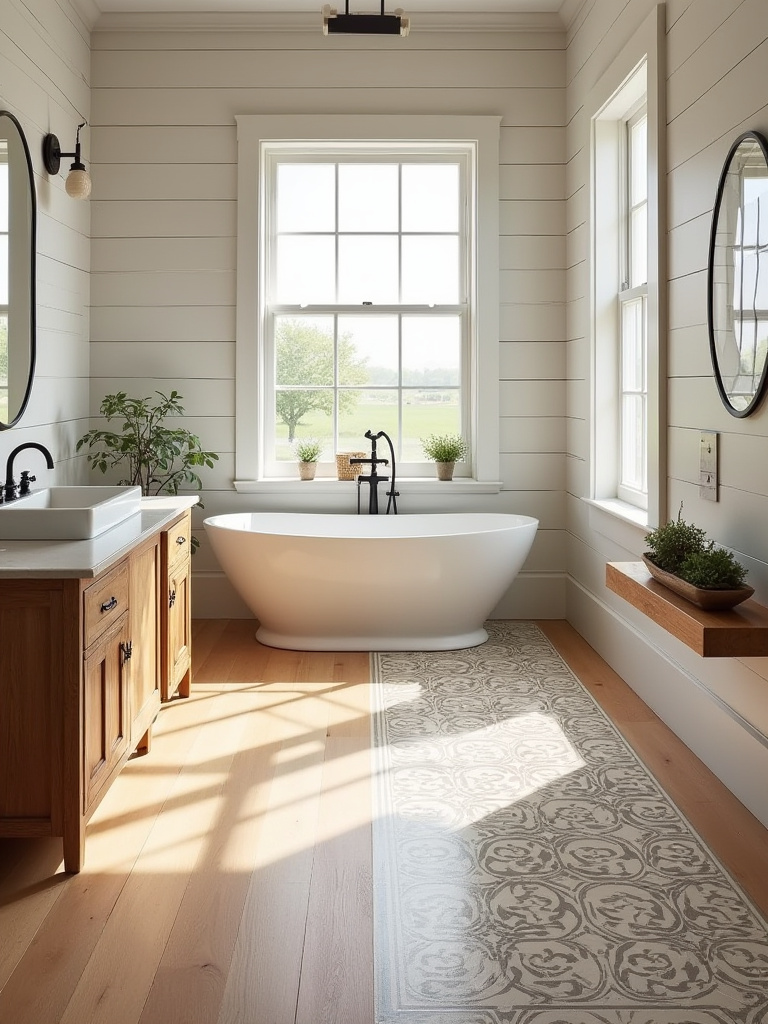
Patterned cement tiles, on the other hand, tell a story of craft and history. Each tile can be slightly different, a testament to the hands that made it. The pattern brings a gentle energy and artistry to the floor, transforming it from a mere surface into a piece of decorative art that you get to walk on every day.
Adding Character: Styling with Textiles and Decorative Touches (Part 1)
With the foundation set, we can now add the layers that bring softness, personality, and life to the bathroom. This is where the space truly becomes yours. These touches should be chosen with the same intention as the larger fixtures—curated slowly, with an eye for meaning and authenticity, not just decoration.
13. Integrating Authentic Vintage Finds: Antiques, Rustic Crates, and Heirloom Pieces
This is the heart of creating a space with soul. A new object has no story. An antique or a vintage find brings with it an invisible history. An old wooden crate used for shelving, a small silver dish from a flea market to hold soap, a weathered stool beside the tub—these pieces are imbued with the energy of their former lives.
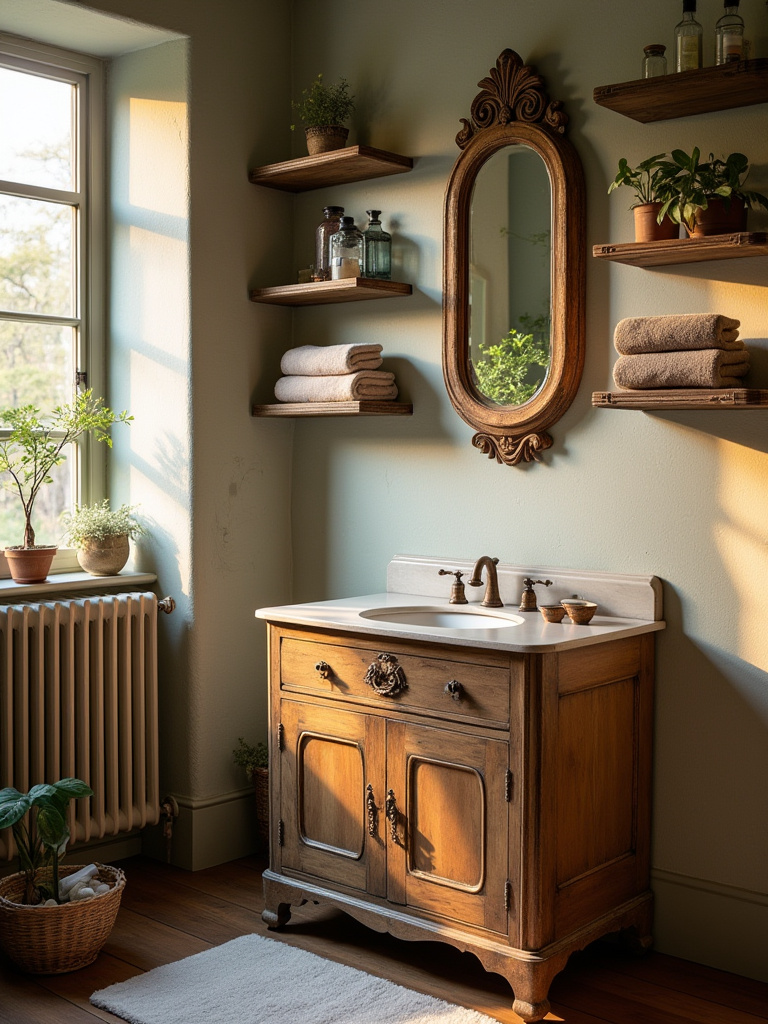
Do not rush this process. A room that feels authentic is one that has been collected over time. Let these objects find you. When you choose a piece because it speaks to you, because you wonder about its past, it ceases to be mere decoration. It becomes a point of connection and a quiet companion in your space.
14. Selecting Farmhouse-Inspired Textiles: Waffle Weave, Soft Linen, and Organic Cotton
After all the hard surfaces—the wood, stone, and tile—the space needs softness. It needs a tactile counterpoint that is gentle against the skin. Natural fibers are essential. Linen has a beautiful, rumpled quality that is perfectly in line with the wabi-sabi ethos; it is not meant to be perfectly pressed.
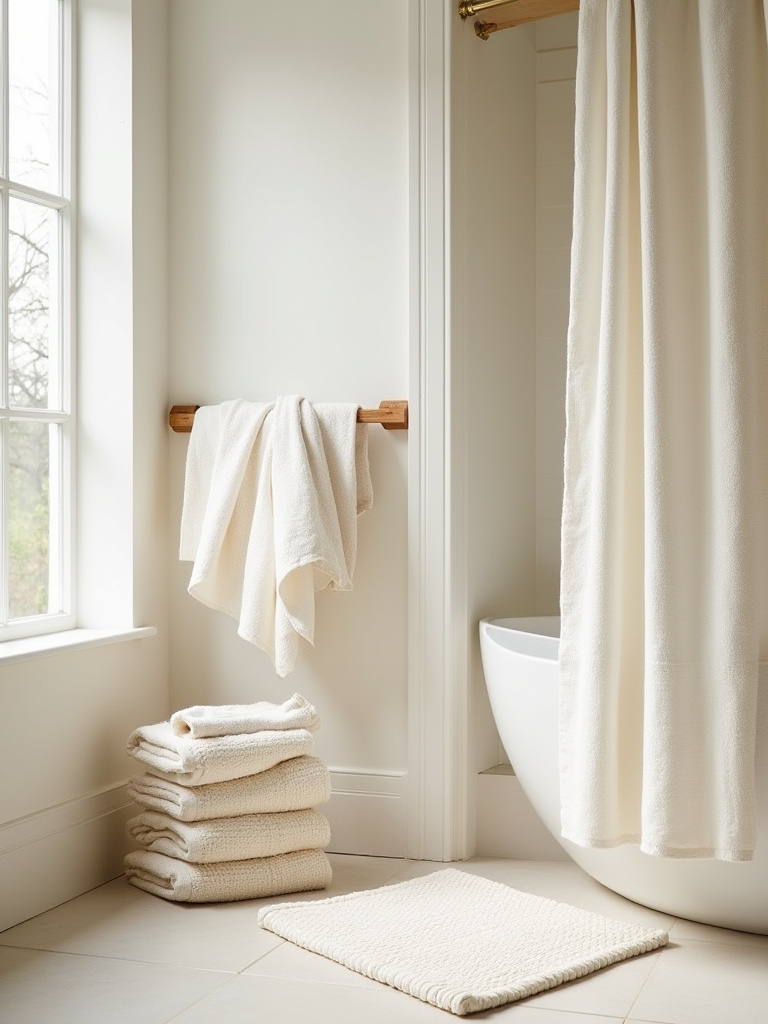
A waffle-weave or thick organic cotton towel provides a comforting texture that feels both humble and luxurious. Think about a simple linen shower curtain that filters the light softly, or a thick, absorbent bath mat underfoot. These textiles are not just functional; they are a critical part of the sensory experience, offering warmth and comfort.
15. Showcase Rustic Wall Art: Botanical Prints, Galvanized Metal Signs, or Mason Jar Displays
Wall art should provide a moment of pause, not a distraction. Instead of generic signs with words, consider images that connect you to the natural world. A simple series of botanical prints showing the anatomy of a fern or a wildflower is a quiet meditation on nature’s intricate beauty. They honor the spirit of the farmhouse without being literal.
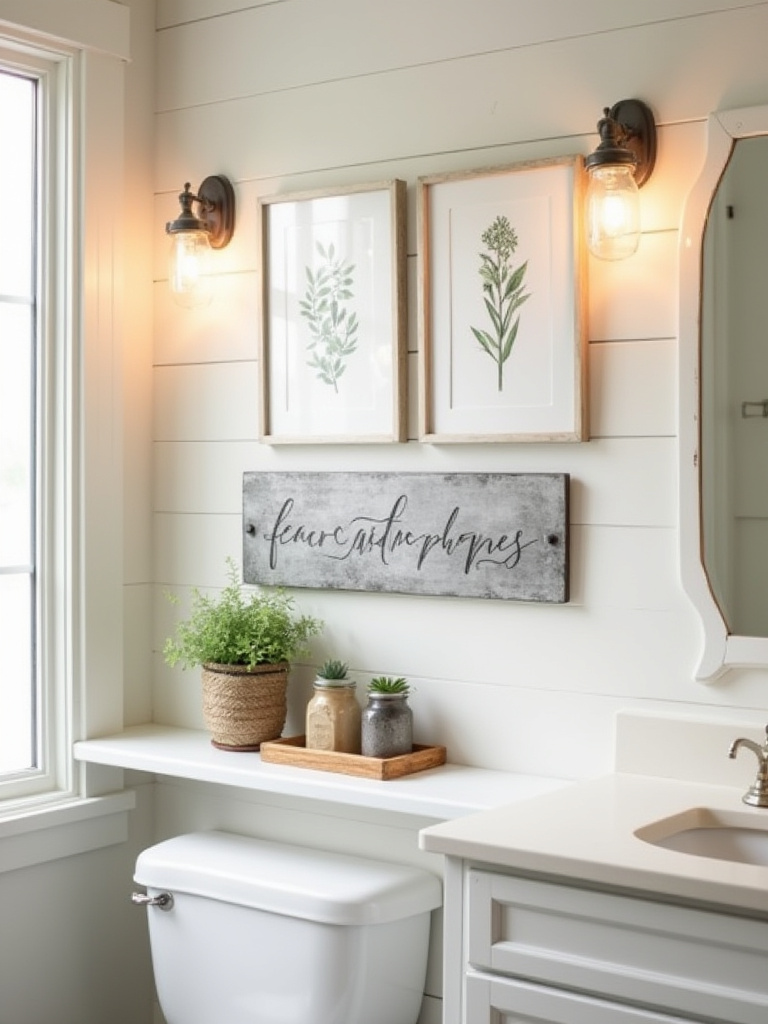
If you must use objects, be intentional. A few empty antique mason jars arranged on a shelf can be a beautiful study in form and light. One of the greatest mistakes is the urge to fill every empty wall. Remember the concept of ma. A small, meaningful piece of art is made more powerful by the empty space that surrounds it.
16. Employ Functional Storage Decoratively: Wire Baskets, Wooden Crates, and Open Shelving
Open storage is an act of mindfulness. Unlike a closed cabinet where things can be hidden in chaos, open shelves and wire baskets demand that you be intentional about what you display. This practice forces you to own fewer, more beautiful things. A simple wooden crate holding neatly rolled white towels becomes a calming, geometric element.
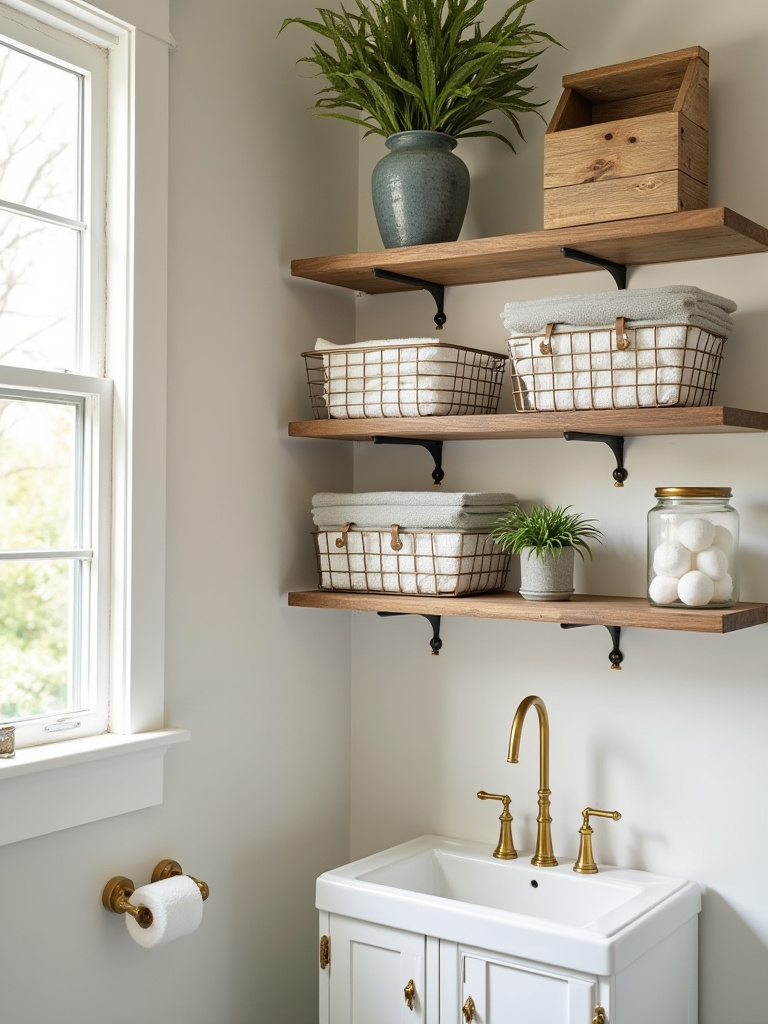
Use apothecary jars for cotton balls or bath salts. This elevates the mundane into something beautiful and organized. The key is to see storage not as a place to hide things, but as an opportunity to curate small, serene compositions with your everyday essentials. Function and beauty become one.
Adding Character: Styling with Textiles and Decorative Touches (Part 2)
We continue to add layers, now focusing on the senses that are often forgotten in design—scent and the ambient feeling of a space. A truly immersive sanctuary engages more than just the eyes. It should be a holistic experience that calms the mind and soothes the spirit from the moment you enter.
17. Curating Cozy Comfort: Scented Candles, Reed Diffusers, and Fluffy Towels
A room’s atmosphere is shaped as much by scent and feel as it is by sight. A subtle, natural fragrance—like lavender, sandalwood, or eucalyptus—can instantly signal to your brain that it is time to relax. Scented candles offer the added benefit of a soft, flickering flame, a primal source of comfort.
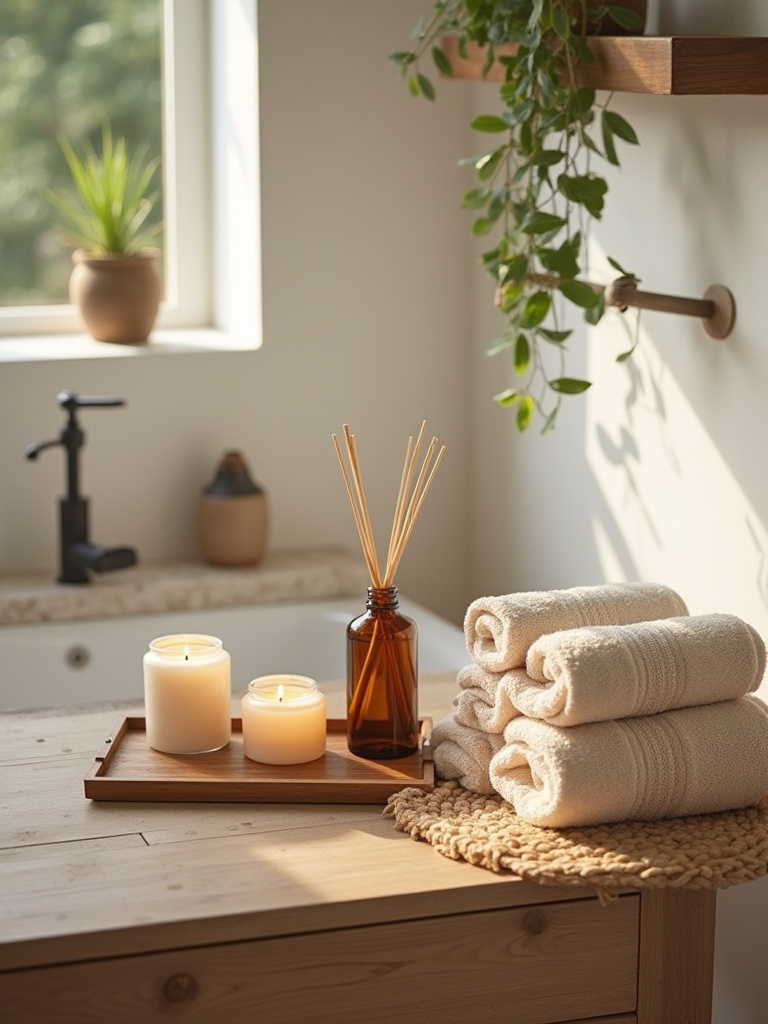
And never underestimate the power of a truly excellent towel. The ritual of bathing should conclude with an embrace of softness and warmth. Investing in high-quality, plush towels is not an indulgence; it is a commitment to a daily moment of comfort and care. These are the details that transform a bathroom from a room into a retreat.
Refinements: Ambiance, Organization, and Sustainable Charm
The final touches are about refining the atmosphere. Lighting, the thoughtful organization of small items, and the inclusion of living things—these are the subtle elements that make a space feel complete, considered, and truly alive. They are the final brushstrokes that bring the entire composition into harmony.
18. Illuminate with Industrial and Rustic Lighting: Edison Bulbs, Barn Sconces, and Pendant Lights
Light is everything. The wrong lighting can make the most beautiful space feel harsh and sterile. Farmhouse lighting is about warmth. Edison-style bulbs, with their visible, glowing filaments, provide a soft, ambient light that feels closer to candlelight than a standard bulb. They are functional, yes, but their primary purpose is to set a mood of restfulness.
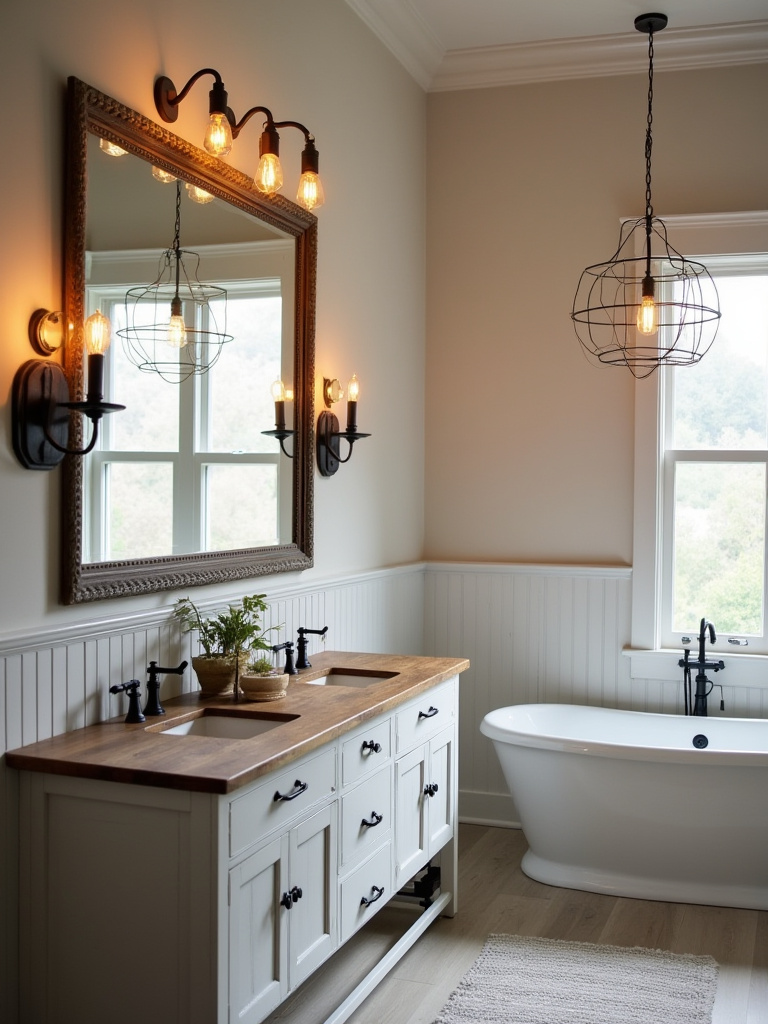
Barn sconces, with their simple, utilitarian forms, provide excellent task lighting by a mirror without sacrificing character. A single pendant light can serve as a sculptural element. The most important tool, however, is the dimmer switch. The ability to lower the lights is essential for transforming the room from a bright, functional space into a restorative, tranquil sanctuary.
19. Creative Toiletries Storage: Apothecary Jars, Tiered Trays, and Wall-Mounted Caddies
The smallest items can create the most visual clutter. By giving them a beautiful and intentional home, you restore a sense of order. Glass apothecary jars are perfect for this. They contain small items while allowing you to see what’s inside, creating a display that is both practical and charmingly old-fashioned.
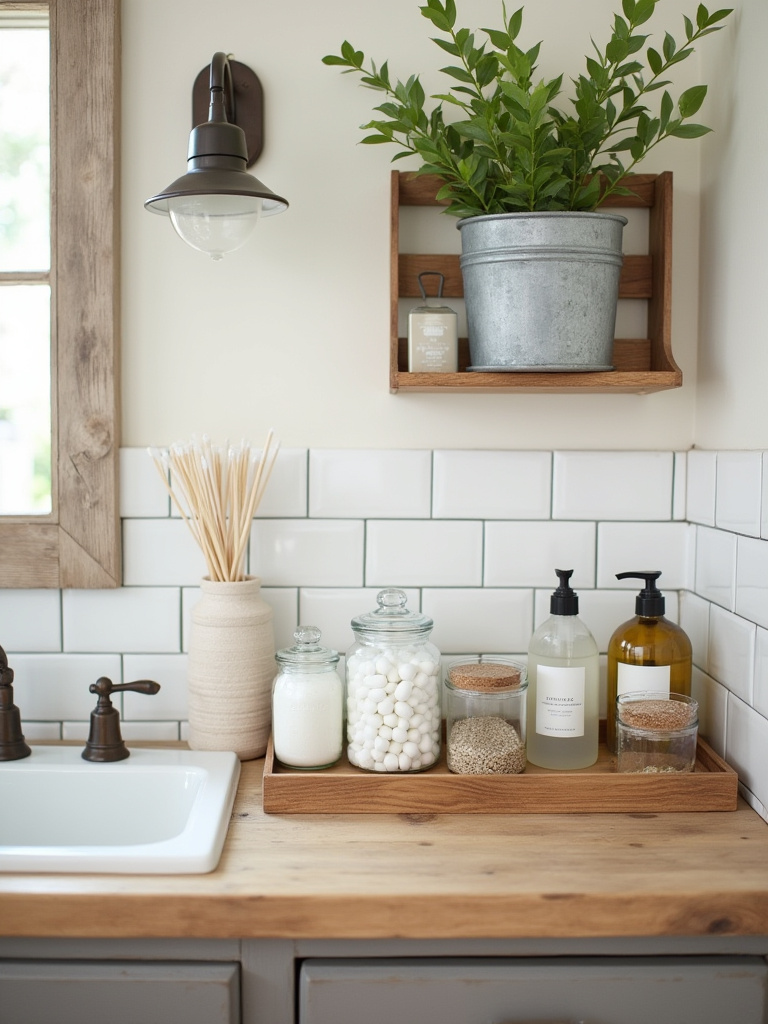
A tiered tray on a vanity is a wonderful way to organize lotions and soaps vertically, freeing up counter space while creating an interesting arrangement. This is the art of honoring the small things. By treating your everyday items with respect and giving them a proper place, you bring a sense of ceremony to your daily routines.
20. Bringing Nature Indoors: Live Plants, Dried Florals, and Terracotta Accents
A room without life feels static. The final, essential element is to bring nature itself into the space. A living plant is not an accessory; it is a quiet roommate. Choose plants that thrive in humidity, like a fern or a pothos. Their greenness brings a sense of vitality and reminds us of the world outside.
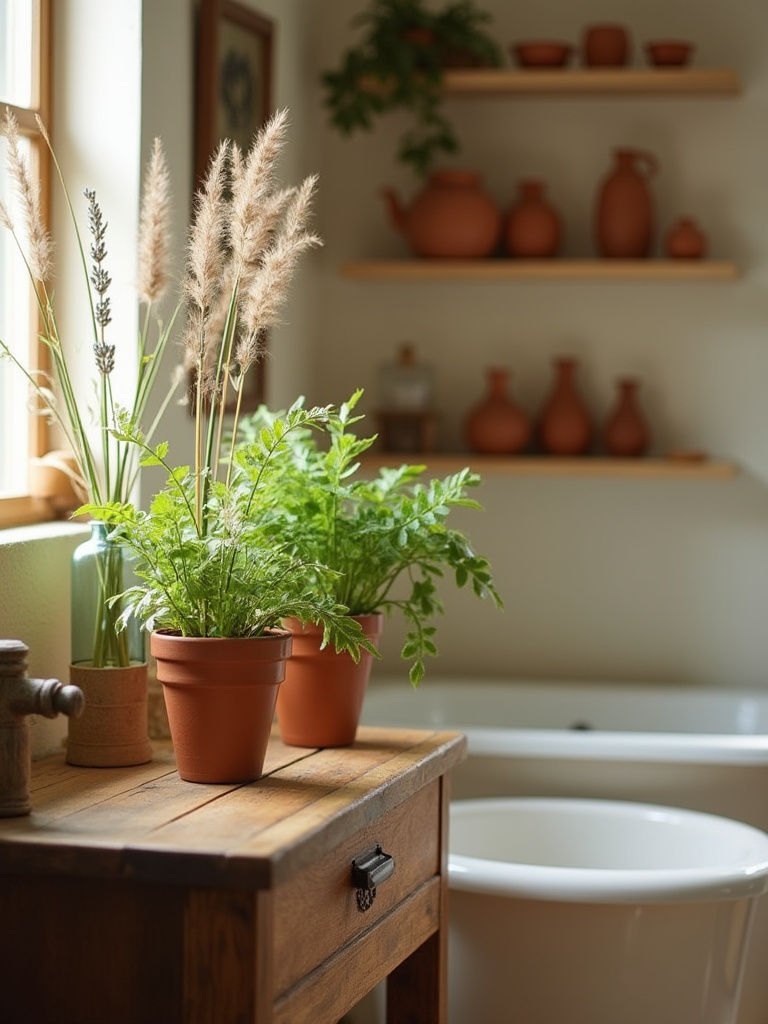
Dried florals, like a bundle of eucalyptus hanging in the shower or lavender in a small vase, provide lasting texture and a gentle scent. And terracotta pots, with their earthy, porous material, add a touch of humble, Mediterranean warmth. These living and preserved natural elements are the final breath of life that makes the space feel whole.
Conclusion
Creating a farmhouse bathroom is not a weekend project of acquiring a checklist of items. It is a slow, mindful process of curation. It is about listening to the space, honoring honest materials, and making choices that cultivate a feeling of peace. It’s about finding the beauty in simplicity and imperfection—the calming presence of wabi-sabi and the quiet power of ma.
You are not just decorating a room. You are crafting a sanctuary for your daily rituals. It should be a place that calms your mind, restores your spirit, and connects you, however briefly, to the simple, grounding beauty of the natural world. Take your time. Choose pieces with story. Create a space that doesn’t just look right, but feels true.
